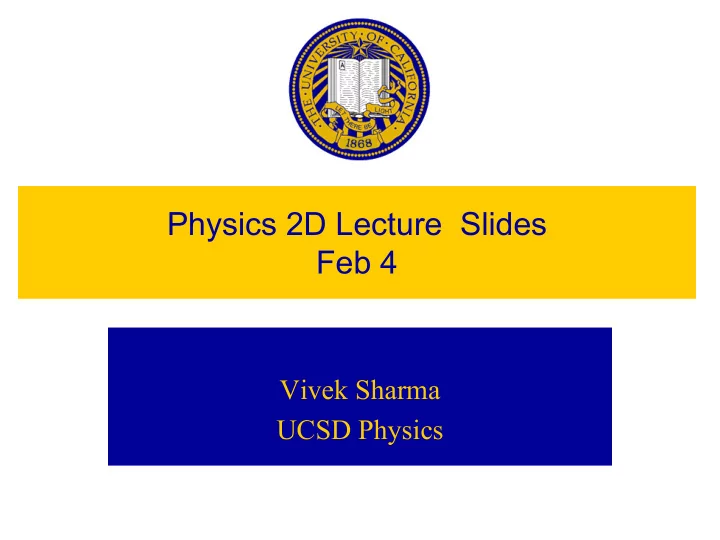

Physics 2D Lecture Slides Feb 4 Vivek Sharma UCSD Physics
Saw what light does, Now examine matter • Fundamental Characteristics of different forms of matter – Mass – Charge • Measurable � � � � –using some combination of E & B = + × F q E ( v B ) – Or E/B and some other macroscopic force e.g. Drag Force
Thomson’s Determination of e/m of Electron • In E Field alone, electron lands at D • In B field alone, electron lands at E • When E and B field adjusted to cancel Each other’s force � electron lands at F � e/m = 1.7588 x 10 11 C/Kg
Millikan’s Measurement of Electron Charge Find charge on oil drop is always in integral multiple of some Q Q e = 1.688 x 10 -19 Coulombs � M e = 9.1093 x 10 -31 Kg � Fundamental properties (finger print) of electron (similarly can measure proton properties etc)
Where are the electrons inside atoms? Early Thought: “Plum pudding” model � Atom has a homogenous distribution of Positive charge with electrons embedded in them (atom is neutral) e - Positively charged e - + Core matter e - e - e - e - e - e - e - e - e - e - e - e - e - e - e - ? e - e - • How to test these hypotheses? � Shoot “bullets” at the atom and watch their trajectory. What Kind of bullets ? •Indestructible charged bullets � Ionized He ++ atom = α ++ particles •Q = +2e , Mass M α =4amu >> m e , V α = 2 x 10 7 m/s (non-relavistic) [charged to probe charge & mass distribution inside atom]
Plum Pudding Model of Atom • Non-relativistic mechanics (V α /c = 0.1) • In Plum-pudding model, α -rays hardly scatter because – Positive charge distributed over size of atom (10 -10 m) – M α >> M e (like moving truck hits a bicycle) – � predict α -rays will pass thru array of atoms with little scatter (~1 o ) Need to test this hypothesis � Ernest Rutherford
Probing Within an Atom with α Particles Most α particles pass thru gold foil with nary a deflection • SOME ( ≅ 10 -4 ) scatter at LARGE angles Φ • • Even fewer scatter almost backwards � Why
“ Rutherford Scattering” discovered by his PhD Student (Marsden)
Rutherford Discovers Nucleus (Nobel Prize)
Force on α -particle due to heavy Nucleus α particle trajectory is hyperbolic Scattering angle is related to impact par. •Outside radius r =R, F ∝ Q/r 2 θ kq Q = α Impact Parameter b cot 2 •Inside radius r < R, F ∝ q/r 2 = Qr/R 2 2 m v α α •Maximum force at radius r = R
Rutherford Scattering: Prediction and Experimental Result 2 2 4 k Z e NnA ∆ = n 2 1 ϕ 2 2 4 4 R m v Sin ( / 2) α α 2 •# scattered Vs φ depends on : •n = # of incident alpha particles •N = # of nuclei/area of foil •Ze = Nuclear charge • K α of incident alpha beam •A= detector area
Rutherford Scattering & Size of Nucleus ∝ distance of closest appoach r size of nucleus 1 α 2 Kinetic energy of = K = 2 m v α α β α particle will penetrate thru a radius r until all its kinetic energy is used up to do work AGAINST the Coulomb potent ial of the Nucleus: ( )( ) Ze 2 e 1 = = 2 K = m v 8 MeV k α α β 2 r 2 2 kZe ⇒ = r K α = For K =7.7.MeV, Z 13 α Al 2 2 kZ e − ⇒ = = × 15 r 4.9 10 m K α - 15 Size of Nucleus = 10 m -10 Siz e of Ato m = 1 0 m
Recommend
More recommend